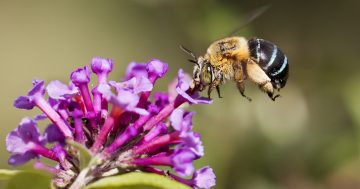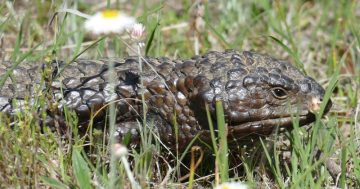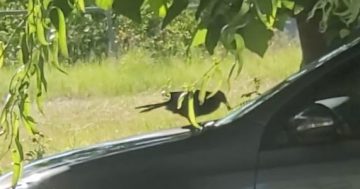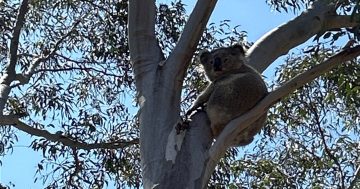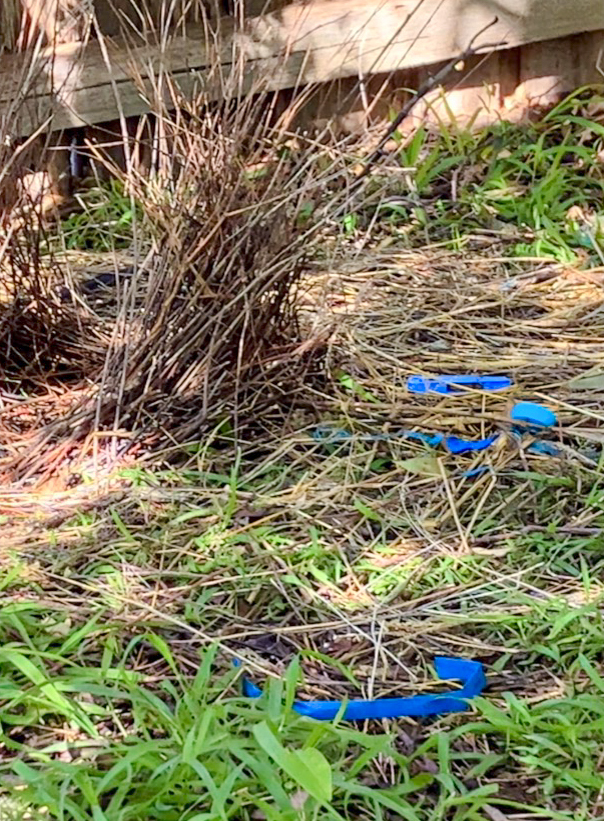
The bowerbird’s bower under construction in my backyard. Photo: Chris Johnson.
It’s a story of courtship and romance, of commitment and competition, of triumph and tragedy, all played out in a Canberra backyard.
It’s the true, eyewitness account of one very determined satin bowerbird (Ptilonorhynchus violaceus) who visited my suburban block and decided to make it the place he would find a mate.
I had heard about this natural phenomenon, but had never observed up close (or from any distance actually) a bowerbird building a bower to attract a female.
We noticed it one morning while gazing out the French windows of the bedroom.
There, just three metres away from us was an impressive structure taking shape, made from twigs and grasses.
And then we saw the busy bowerbird.
He flew in under the branches of the overhanging shrubbery providing shelter for his bower and got to work stacking, weaving and pruning the construction.
Then he jumped onto the fence before disappearing to who knows where and returning a few minutes with more building materials.
The little tower being built was about 30 centimetres tall and coming together in quite a symmetrical form.
In addition to the outstanding craftsmanship displayed in the bower itself, there was a buffer of blue plastic scraps strewn all around its entrance.
Pieces of clothes pegs, ribbons, plastic lids, small strips of foam – all blue and all strategically positioned around the bower.
I could identify most of the blue trinkets from my own backyard, but not everything.
Then we saw the bird fly in from over the fence carrying something blue between its beak. This bowerbird was foraging far and wide.
We watched this activity for a couple of weeks. We were suitably impressed, but not as much it seemed as were the ladies who dropped in to visit.
The bower was working.
A female (possibly two) dropped in to see the bower – and that’s when this young rooster stepped it up.
We were amazed by the courtship ritual the male bowerbird employed.
While the female positioned herself under and beside the bower, the male – complete with blue ornament in mouth – danced around her with his wings outstretched and head bobbing all over the place.
It was a marvellous thing to witness.
And it seemed to have an impact. She kept coming back.
Male bowerbirds don’t turn that bluey-black satin colour until they are about seven years old.
This male was younger, still sporting the greenish hue that can sometimes make it hard to discern them from the females.
The blue bits hanging from his beak were a giveaway, however.
I have noticed an abundance of bowerbirds in my yard over the past two years. It’s just a suburban block but with plenty of trees and shrubs to attract quite an array of birdlife.
At the moment there is a pair of tawny frogmouths (Podargus strigoides) perched each day on the branch of a large bottlebrush overhanging the front driveway.
Didn’t notice them until I went to lop off the annoying branch, but couldn’t do it once I spotted them.
Now we enjoy watching them from our front patio as they fly off in the evening for their night-time hunt – leaving the drooping branch to keep scraping the tops of our cars.
I lost a tiny bottle opener I had been leaving on the front patio table when I first noticed all the bowerbirds hanging around our house about two years ago.
It was a super light toy from a Christmas cracker, but it opened a bottle with ease.
It also happened to be bright blue.
When it disappeared, it was suggested to me a bowerbird had probably stolen it right off the front porch.
I didn’t really believe it then, but now I do.
Seeing all the stolen blues things around the bower in my backyard this year gives me some satisfaction that my bottle opener helped a romance two years ago. Isn’t that what bottle openers are for anyway?
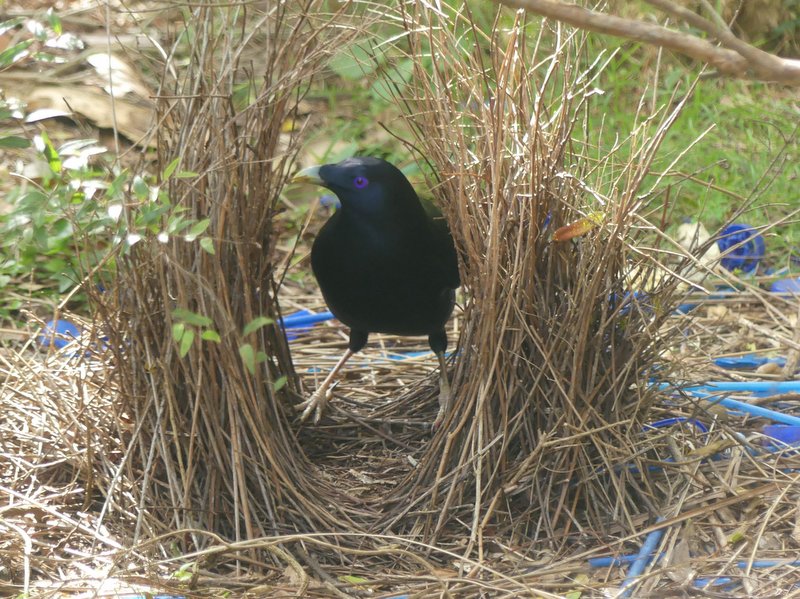
A Satin Bowerbird male in his bower. Photo: Ian Fraser.
Back to our current casanova; he was a delight to watch. We saw him construct a loveshack and bring a girlfriend or two home.
A saucepan of fresh water encouraged the birds to linger.
We kept pets out of the backyard while this marvel unfolded before our eyes.
Then suddenly, it was gone.
One day we noticed the bower had disappeared completely. It had been flattened and removed.
At first I feared a neighbourhood cat might be to blame, until I realised the blue trinkets were all gone too. A cat wouldn’t do that.
Devastated, we did some research and discovered that quite often other young male bowerbirds will steal from the bowers of their rivals and even destroy them.
That’s probably what happened. There’s no honour among thieves.
Or maybe, considering bowers are not actual nests and that females lay eggs above the ground, the structure had served its purpose for our young male and he moved it all on.
We’ll never know.
Original Article published by Chris Johnson on Riotact.




